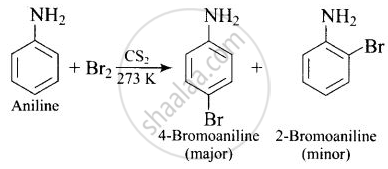Advertisements
Advertisements
प्रश्न
Predict the product of reaction of aniline with bromine in non-polar solvent such as \[\ce{CS2}\].
उत्तर

In non-polar solvent (such as \[\ce{CS2}\]) the activating effect of -NH2 group is reduced (due to resonance) and hence, mono substitution occurs only at o- and p-positions.
APPEARS IN
संबंधित प्रश्न
Illustrate the following reaction giving suitable example in each case: Diazotisation
Why does acetylation of –NH2 group of aniline reduce its activating effect?
Why is aniline soluble in aqueous HCl?
How will you carry out the following conversions?
toluene `->` p-toluidine
Match the compounds given in Column I with the items given in Column II.
| Column I | Column II | ||
| (i) | Benzene sulphonyl chloride | (a) | Zwitter ion |
| (ii) | Sulphanilic acid | (b) | Hinsberg reagent |
| (iii) | Alkyl diazonium salts | (c) | Dyes |
| (iv) | Aryl diazonium salts | (d) | Conversion to alcohols |
A colourless substance ‘A’ \[\ce{(C6H7N)}\] is sparingly soluble in water and gives a water soluble compound ‘B’ on treating with mineral acid. On reacting with \[\ce{CHCl3}\] and alcoholic potash ‘A’ produces an obnoxious smell due to the formation of compound ‘C’. Reaction of ‘A’ with benzenesulphonyl chloride gives compound ‘D’ which is soluble in alkali. With \[\ce{NaNO2}\] and \[\ce{HCl}\], ‘A’ forms compound ‘E’ which reacts with phenol in alkaline medium to give an orange dye ‘F’. Identify compounds ‘A’ to ‘F’.
Aniline when treated with cone. HNO3 gives
Which of the following is the most stable diazonium salt?
Aniline dissolved in dilute HCl is reacted with sodium nitrate at 0 °C. This solution was added dropwise to a solution containing equimolar mixture of aniline and phenol in dil. HCl. The structure of the major product is:
Identify A and B for the following reaction:

What are polymers?
